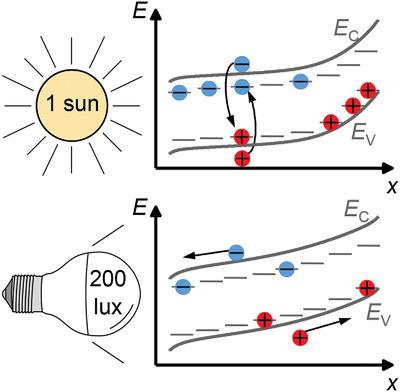当前位置:
X-MOL 学术
›
Adv. Theory Simul.
›
论文详情
Our official English website, www.x-mol.net, welcomes your
feedback! (Note: you will need to create a separate account there.)
The Influence of Photo‐Induced Space Charge and Energetic Disorder on the Indoor and Outdoor Performance of Organic Solar Cells
Advanced Theory and Simulations ( IF 2.9 ) Pub Date : 2021-02-11 , DOI: 10.1002/adts.202000319 Sebastian Beuel 1 , Paula Hartnagel 2 , Thomas Kirchartz 1, 2
Advanced Theory and Simulations ( IF 2.9 ) Pub Date : 2021-02-11 , DOI: 10.1002/adts.202000319 Sebastian Beuel 1 , Paula Hartnagel 2 , Thomas Kirchartz 1, 2
Affiliation

|
Apart from traditional large‐scale outdoor application, organic solar cells are also of interest for powering small, off‐grid electronic devices indoors. For operation under the low light intensities that are typical for indoor application, a high shunt resistance is required calling for thick active layers in industrial processing to ensure maximum coverage. However, the thickness of an organic solar cell based on energetically disordered semiconductors is limited by space‐charge effects from charged shallow defects under nonuniform generation. While other sources of space charge such as doping and asymmetric transport have been extensively discussed in previous studies, this work offers a theoretical analysis of this photo‐induced space charge in shallow defects and visualizes how the space charge builds up with increasing light intensity with drift‐diffusion simulations. It is shown that the effect particularly deteriorates the performance of an organic solar cell with high active‐layer thickness and substantial energetic disorder. However, the simulations reveal that solar cells are less sensitive to these parameters under low light intensities due to a reduced density of photo‐induced space charge. Therefore, a wider range of material systems and absorber thicknesses can be viable for indoor applications than one may initially expect from testing under 1 sun illumination.
中文翻译:

光诱导的空间电荷和高能紊乱对有机太阳能电池室内外性能的影响
除了传统的大型户外应用外,有机太阳能电池还可以为室内小型离网电子设备供电。对于在室内典型的低光照强度下运行,要求高分流电阻,要求在工业处理中使用厚的有源层,以确保最大的覆盖范围。然而,基于能量无序半导体的有机太阳能电池的厚度受到不均匀产生下带电浅缺陷的空间电荷效应的限制。虽然先前的研究已经广泛讨论了其他空间电荷来源,例如掺杂和不对称传输,这项工作为浅缺陷中的这种光致空间电荷提供了理论分析,并通过漂移扩散模拟可视化了空间电荷如何随着光强度的增加而累积。结果表明,这种作用会特别破坏具有高活性层厚度和高能紊乱的有机太阳能电池的性能。然而,仿真表明,由于光致空间电荷的密度降低,太阳能电池在低光强度下对这些参数不那么敏感。因此,比起最初在1种日光下进行测试所期望的材料范围,材料应用系统和吸收器厚度范围更适合室内应用。结果表明,这种作用会特别破坏具有高活性层厚度和高能紊乱的有机太阳能电池的性能。然而,仿真表明,由于光致空间电荷的密度降低,太阳能电池在低光强度下对这些参数不那么敏感。因此,比起最初在1种日光下进行测试所期望的材料范围,材料应用系统和吸收器厚度范围更适合室内应用。结果表明,这种作用特别会使具有高活性层厚度和高能紊乱的有机太阳能电池的性能下降。然而,仿真表明,由于光致空间电荷的密度降低,太阳能电池在低光强度下对这些参数不那么敏感。因此,比起最初在1种日光下进行测试所期望的材料范围,材料应用系统和吸收器厚度范围更适合室内应用。
更新日期:2021-03-09
中文翻译:

光诱导的空间电荷和高能紊乱对有机太阳能电池室内外性能的影响
除了传统的大型户外应用外,有机太阳能电池还可以为室内小型离网电子设备供电。对于在室内典型的低光照强度下运行,要求高分流电阻,要求在工业处理中使用厚的有源层,以确保最大的覆盖范围。然而,基于能量无序半导体的有机太阳能电池的厚度受到不均匀产生下带电浅缺陷的空间电荷效应的限制。虽然先前的研究已经广泛讨论了其他空间电荷来源,例如掺杂和不对称传输,这项工作为浅缺陷中的这种光致空间电荷提供了理论分析,并通过漂移扩散模拟可视化了空间电荷如何随着光强度的增加而累积。结果表明,这种作用会特别破坏具有高活性层厚度和高能紊乱的有机太阳能电池的性能。然而,仿真表明,由于光致空间电荷的密度降低,太阳能电池在低光强度下对这些参数不那么敏感。因此,比起最初在1种日光下进行测试所期望的材料范围,材料应用系统和吸收器厚度范围更适合室内应用。结果表明,这种作用会特别破坏具有高活性层厚度和高能紊乱的有机太阳能电池的性能。然而,仿真表明,由于光致空间电荷的密度降低,太阳能电池在低光强度下对这些参数不那么敏感。因此,比起最初在1种日光下进行测试所期望的材料范围,材料应用系统和吸收器厚度范围更适合室内应用。结果表明,这种作用特别会使具有高活性层厚度和高能紊乱的有机太阳能电池的性能下降。然而,仿真表明,由于光致空间电荷的密度降低,太阳能电池在低光强度下对这些参数不那么敏感。因此,比起最初在1种日光下进行测试所期望的材料范围,材料应用系统和吸收器厚度范围更适合室内应用。











































 京公网安备 11010802027423号
京公网安备 11010802027423号